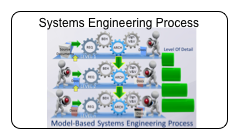The Systems Engineering Management Plan (SEMP) is a great document for describing to the systems engineering team and other stakeholders how the systems engineers will provide the solution. Systems engineering is as much about communication as it is about engineering. To be successful we have to communicate to others how we are going to provide a solution as well as describe the solution itself.
When teaching the MBSE training course I’m often asked how the knowledge the students have gained on the STRATA methodology and the use of GENESYS and CORE can be integrated into their projects. The SEMP provides a good means of showing how the methodology and people will deliver the solution using the tools.
As we engineer our solution there are three systems we have to deal with:
1. The system of interest we are developing as our solution;
2. The system of processes and methodology, and the organization we will use to develop our solution;
3. The systems engineering tools, such as GENESYS and CORE, we will use to support our processes and organization.
For the successfully delivery of model-based systems engineering (MBSE) we must communicate with others about these three systems and how they are inter-related. If we do not explain these things then our team and our stakeholders will not know why and how we are doing something.
The Systems Engineering Management Plan
The SEMP is an essential document for communicating how the system solution will be engineered.
The SEMP provides a place to document how we will develop the solution and, as a consequence, the SEMP provides a place to discuss the relationships between the system of interest, the process and organization, and the systems engineering tool.
The popular textbooks on systems engineering provide a discussion on the SEMP and its structure. Typically the SEMP is described as containing three sections1,2:
1. Technical program planning, implementation & control;
2. Systems engineering process;
3. Engineering specialty integration.
As a living document, the SEMP allows the systems engineering team to record their ways of working and communicate those processes to the other stakeholders. The SEMP is created in the early stages of the project and as the systems engineers’ understanding of the project develops, the SEMP is updated to reflect the new insight.
Using the SEMP
Information on how a project will use our STRATA MBSE methodology and CORE tool can be captured in the SEMP. For example, the following can be captured under the various sections:
1. Technical program planning, implementation, and control:

In this section, capture the systems engineering team organization, including the “back office” roles supporting the systems engineering tool. Role descriptions can identify who is responsible for: administering the tools; configuration management of the GENESYS/CORE repository; developing reports and scripts, etc.
2. Systems engineering process:

This section is ideal for discussing the STRATA MBSE methodology and how it will be used to engineer the solution. If more detail is required then the SEMP can provide references to more detailed documents such as System Definition Guide (SDG) and Architecture Definition Guide (ADG). The SDG and ADG are included in the help and support documents that Vitech provides with both GENESYS and CORE.
3. Engineering specialty integration

In this section, document the information to be captured and exchanged with the specialty engineering teams. This description can include what will be captured in the systems engineering tool (e.g. elements, attributes and relationships), and how it will be exchanged (e.g., CSV). If there are specific roles within the systems engineering team for dealing with the engineering specialty integration that can be captured within the SEMP.
The SEMP is a project-specific document. It has to balance the usual systems engineering tasks with the delivery of a specific solution for a particular project. In addition, the SEMP needs to describe how the systems engineering tools will be used. Balancing these three aspects means that there is not a generic version of a SEMP that could cover every project. The effort taken in creating and maintaining the SEMP will pay off as there will be a concise vision of what is to be done and a description of how it will be achieved.
Use the SEMP as a living document to capture how you will engineer your system solution. The SEMP allows you to describe the methodology you will follow and how your systems engineering organization and tools will support that methodology. As the project moves through its various phases keep the SEMP up to date with how the systems engineering will be conducted.
Bibliography
1. Systems Engineering and Analysis, 5th Edition, B.S. Blanchard, W.J. Fabrycky, Prentice Hall, 2011.
2. Systems Engineering Principles and Practice, A. Kossiakoff, W.N. Sweet, Wiley, 2003.
3. Decision Making in Systems Engineering and Management, 2nd Edition, G.S. Parnell, P.J. Driscoll, D.L. Henderson, Wiley, 2011.






